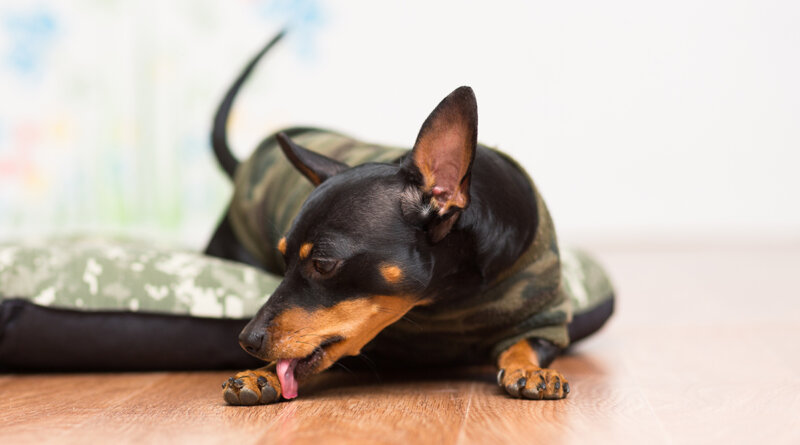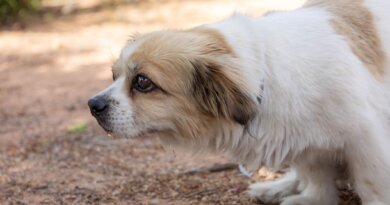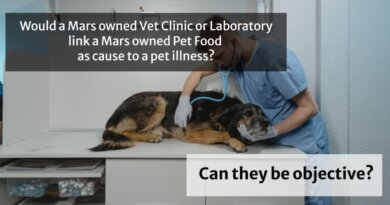Why is My Dog Excessively Licking His Paws?
Paw licking is a common behavior in dogs, but a healthy dog should not excessively paw lick, and a history of excessive licking could be a red flag for a more serious problem. While it’s true they might simply be grooming themselves, paw chewing could indicate something more going on if they are doing it all the time. It doesn’t help that all that constant foot licking can also cause a secondary infection (bacterial or yeast) due to the extra moisture.
An allergic reaction in the skin is the most common reason why dogs will chew their paws excessively. The good news here is that many of the causes of a dog’s paw licking can be resolved with home treatment alone.
So, why do dogs lick in the first place?
Common Causes for Paw Licking
Food Allergies
Environmental Allergies
Flea Allergies
Dry Skin
Obsessive Behavior
Anxious Behavior
GET THE BARK IN YOUR INBOX!
Sign up for our newsletter and stay in the know.
FOOD & ENVIRONMENTAL ALLERGIES
Food allergies occur when the immune system of your dog overreacts to some of the protein in the ingested food. An important note is that a food allergy differs from a food sensitivity in that allergies will cause an immediate immune reaction. The most common foods that cause allergies in dogs include beef, dairy, wheat egg and chicken. Dogs lick to relieve the itchiness caused by food allergy. Symptoms of food allergies can include itchy rash, paw licking, hot spots, diarrhea and vomiting.
For environmental allergies like atopic dermatitis, increased ear-scratching and foot-licking are common reactions to things like grass, mold spores, dust mites, and plant pollens. If you find your dog licking excessively more frequently after trips to the park or a walk around the block it’s likely they have an environmental allergy. Symptoms of environmental allergies can include increased sneezing, running eyes, paw licking, itchy skin and rashes.
FLEA ALLERGIES
When a dog’s immune system overreacts to flea saliva it’s called flea allergy dermatitis (FAD). This allergic reaction causes an irritation in the skin which usually results in an extremely itchy sensation for the poor afflicted dog. Dogs will typically scratch and lick in an attempt to sooth the itch caused by flea allergies. Symptoms of FAD can include fur loss, thickened skin, redness, paw licking, and hot spots.
DRY SKIN
Dry skin is one of the most common dog skin ailments which causes a dog’s skin to become irritated, cracked and flaky (dandruff). Flaky skin can be caused by many things including excessive bathing which removes a dog’s natural oils, dry humidity, or by the allergies mentioned above. It’s important to follow a good grooming schedule to ensure your dog’s coat stays healthy. Symptoms of dry skin can include itchiness, fur loss, redness, dandruff and scabs.
OBVESSIVE & ANXIOUS BEHAVIOR
If no known health-related reason can be found for the excessive paw licking, then it could be behavioral. Dogs, like people, often seek ways to comfort themselves in times of stress. Is there a change in environment (noises, routine, new pets, or people) that might cause your dog to seek this form of stress relief? In addition to stress, some dogs have canine compulsive disorder which is a form of obsessive compulsive disorder, but in dogs. Common compulsive behaviors for dogs with CCD include paw licking, toy/blanket sucking, tail licking and tail chasing. Try to identify the causes of your dog’s stressful and anxious behavior and use redirection and exercise to relieve it.
You know your dog better than anyone else so to help identify an abnormal situation, you must first know what is normal for your dog. Changes in health are often subtle, or happen over a longer period of time, making noticing a problem more difficult.
As always, if you have any concerns whatsoever especially if the paw chewing is sudden, excessive and persists for long periods of time, it is best to have your veterinarian assess them.



